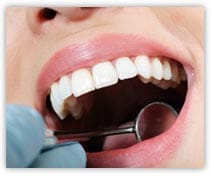 Lumineers are a popular veneer option because they are a “minimal preparation” or “no-preparation” procedure that is attractive to both dentists and patients who benefit from the concept of tooth preservation.
Lumineers are a popular veneer option because they are a “minimal preparation” or “no-preparation” procedure that is attractive to both dentists and patients who benefit from the concept of tooth preservation.
This technique is best used with patients who have spacing in their smile and only minor tooth rotations.
Most cosmetic dentists employ conservative bonding techniques in which they only remove enough surface enamel to allow a ceramist to make life-like teeth for patients.
Often Lumineers do not require the dentist to grind, cut or file down any tooth structure for proper placement.
The veneers are adhesively bonded to the “facial (front) surface” of the teeth, making the process as much of a minimally invasive procedure as possible.
Lumineers vs. Traditional Veneers
Traditional veneers and their thick nature require the grinding down of your original tooth structure.
This can be a painful, anxious experience that many patients would prefer to avoid. Lumineers are unique in that they are ultra-thin (approximately 0.2 mm) and highly translucent, allowing them to replicate the natural appearance of enamel.
Lumineers are so thin they require little to no tooth reduction and no shots. Once the procedure is completed, there is no tooth sensitivity or placement discomfort, so they look and feel natural from the moment they are placed.
With Lumineers you can eat and drink anything you want with confidence because they are applied in the most durable way possible.
With Lumineers you get:
- A painless procedure
- Sensitivity-free results
- Permanently white results that last
- A quick and easy process
Your Lumineers can be installed in two easy visits to bring out a beautiful new smile.
During the first visit a precision custom mold will be taken so that personalized veneers can be created, then you and your dentist will choose the shade you think works best for your new, permanently white smile.
On your second visit, your Lumineers are checked for fit and shade then painlessly attached giving you a healthy, natural smile.
Lumineers Maybe Suitable for the Following Cosmetic Dental Motives:
- Chipped or cracked teeth
- Stained or discolored teeth
- Spaced teeth
- Misshapen teeth
- Slightly crowded teeth
- Worn teeth
- Small teeth
- A “Hollywood” smile
- Braces substitute

Lumineers Alternatives
Lumineers are not the only minimal preparation veneer on the market.
However, they are the most heavily marketed and closest to any “household name” that you will find for veneers to remedy discolored, crooked, chipped, misaligned or otherwise misshapen teeth.
Lumineers may not be appropriate for all dental conditions such as severely misaligned teeth.
They are appealing because they can quickly transform a smile however for misaligned teeth your dentist might recommend orthodontic treatments such as braces or Invisalign.
Also if a whiter more vibrant smile is what you are seeking in-office teeth cleaning such as Zoom whitening or a take-home whitening kit might be suggested by your cosmetic dentist.
Composite bonding may also be an alternative to Lumineers when small chips or cracks in a single tooth are the dental issues.
These procedures are much less costly and are a quicker cosmetic dentistry solution. Your cosmetic dentist will examine your teeth to determine if you are a candidate for Lumineers and may suggest these other options depending on your specific conditions and budget.
Will Dental Insurance Cover Lumineers Costs?
Most dental insurance providers will not cover the costs of cosmetic dentistry procedures such as Lumineers or teeth whitening.
Dental insurance is traditionally reserved for procedures that are necessary, no elected. Your cosmetic dentist may provide affordable dental financing plans or may suggest other treatments that may be covered by your insurance such as braces.
